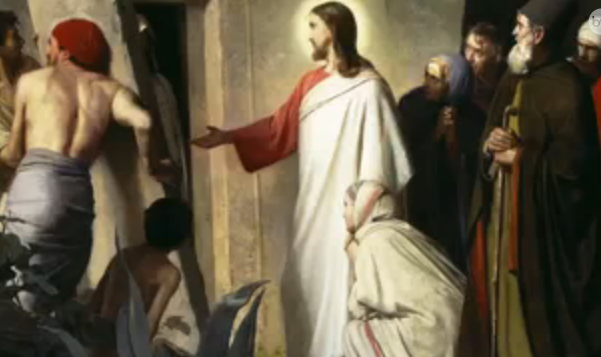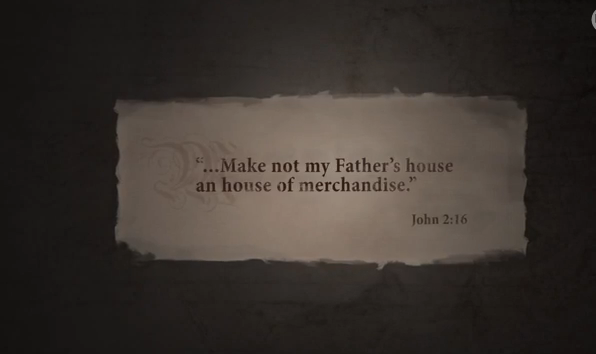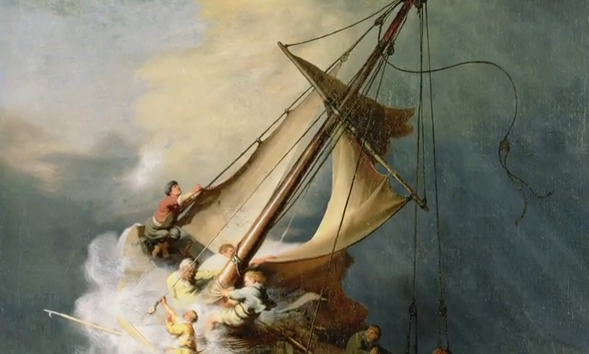JOHN S. TANNER: I love that, because it says that He cares about both our spirits and our physical being. He’s the Redeemer of both, our bodies and our spirits, the whole person.
S. KENT BROWN: I think that’s such an important concept in our theology.
JOHN S. TANNER: I believe that. I think our theology is a theology of the body and the spirit which is the soul of man. It’s about the whole being that’s saved by the gospel of Jesus Christ.
MARCUS H. MARTINS: These miracles of feeding multitudes provide a powerful parallel with the Old Testament accounts of the Exodus. Now this is a way by which the Savior chose to prove that He was indeed the God of Israel. Now Moses and the children of Israel spent forty years in the wilderness being fed on an almost daily basis by the Lord, and he provided them manna while they were in the wilderness. Now centuries later the Savior is taking these multitudes of Israelites to desert places, the gospel writers tell us, and He is feeding them in the same manner that He had done with the ancient Israelites, He’s feeding these people by miraculous means in the wilderness. This powerful parallel certainly would not have escaped the scholars of the era. Jesus of Nazareth was not only claiming but He was proving that He was indeed the same one who had provided manna in the wilderness, and that He was their long-awaited Messiah.
Now what we find is that between the feeding of 5000 and the feeding of 4000, there was another encounter of the Savior with the multitudes in which He refused to perform the miracle. On the very next day after feeding 5000, the Savior is met by another crowd of people, but He perceives their thoughts and he rebukes them saying, You came here because you were fed last time. And at that point, He gives them this great sermon called the Bread of Life.
JOHN F. HALL: He shows His true identity. He witnesses His role, and testifies of His own role as the Savior, as the one who will bring salvation. And He teaches the bread that we should seek is the eternal bread of life, not earthly bread, that He has that eternal bread that can bring us salvation. And He goes on to say: I am the living bread which came down from heaven. If any man eat of this bread, he shall live forever, and the bread that I will give is my flesh, which I will give for the life of the world. And so again the Atonement is referenced, the Atonement by which He will accomplish the mission that the Father has given Him, and so be able to enact the plan of salvation.
 MARCUS H. MARTINS: We are told that many of His followers no longer tagged along after that. Now there’s an interesting exchange at this point when these people then abandon the Savior. The Savior turns to the Twelve, and He asks them, Are you going to leave me also?
MARCUS H. MARTINS: We are told that many of His followers no longer tagged along after that. Now there’s an interesting exchange at this point when these people then abandon the Savior. The Savior turns to the Twelve, and He asks them, Are you going to leave me also?
JOHN F. HALL: “Then Simon Peter answered him, Lord, to whom shall we go? Thou hast the words of eternal life, and we believe and are sure that thou art that Christ, the Son of the living God” (John 6:68–69).
The King James translation here, “we believe and are sure” is pretty strong. But the word we translated “we believe” is actually the Greek word pisteuo, and pisteuois even stronger. If I were to render this from John’s Greek, I would translate it “and we have faith.” You see, it’s important that we recognize it’s not just believing, it’s having faith. And through faith we come to knowledge. They knew who Christ was.
Now this is something that each disciple of Christ in any and every age must come to: the recognition that Christ is the Son of God, that He is the only way by which we can return into the presence of the Father. That’s what He teaches in the Bread of Life sermon. It’s a pivotal passage, because He reveals himself and testifies of His own identity, and the apostles testify back to Him that they knew. And so must we all if we are to be true followers of the Savior, and through the Son return to the presence of the Father.
KAYE TERRY HANSON: So what we get as we look at the miracles as He begins to perform them—I especially like looking at John’s account, because he chooses seven to explain. That’s all John teaches us. We get all the other miracles from everybody else, but he especially gets us going from the simplicity of the marriage at Cana, turning the water into wine, clear to Lazarus.
We are aware already that when Jesus goes to Jerusalem, which He has a couple of times, and in fact stuck fairly close to there toward the end of His life, for the last several months He’s been down in that southern area, we are aware that He stays in Bethany with Mary, and Martha, and Lazarus. They are clearly devoted followers. And on this trip He is over in Perea, and Lazarus becomes sick. And Mary and Martha send someone to get the Savior. And when they come to tell Him that Mary and Martha need help, what they say to Him is, “He whom thou lovest is sick” (John 11:3) They don’t even say it’s Lazarus, and He knows. He knows that, He does love Lazarus, and Mary, and Martha.
KERRY MUHLESTEIN: But the Savior has something different in mind at this point. And so He doesn’t go immediately. He sends back a message telling them that this is for the glory of God. Now we don’t know if the message ever got to them, or if Lazarus was dead by the time it got to them. Imagine if Lazarus were already dead, and Mary and Martha hear a message from the Savior that this is for the glory of God. This must have been very confusing for them. But the Savior does nothing for two more days. He stays in Perea, continues his ministry.
KAYE TERRY HANSON: Four full days after Lazarus has been put in the tomb. Now that’s significant, because the Jews believe that the spirit lingers three days with the dead body. So He waits the fourth day to make sure the Jews know that Lazarus is really dead. This is not some sleight of hand, this is not some trick you can explain away some other way. Lazarus is really dead.
CECILIA M. PEEK: Both Mary and Martha remain remarkably and notably faithful in response to Jesus’ arrival. Martha is the first of the two. She hears word and she goes out, we’re told, to meet Him. And when she meets Him, basically the first thing she says to Him is an expression of her ongoing and uninterrupted faith. She says effectively, if you had been here, he would not have died. And Jesus says, he will rise again. And she says, yea, I know that he will—but she seems to understand this as a reference to the resurrection at the last day. But then Christ says to her—and it seems to be a private exchange between just the two of them—He says, “I am the resurrection and the life.” This is one of the most emphatic statements in John, and it’s made in this very interesting and private and intimate exchange just between Jesus and Martha. She is one of the first people actually that He is that explicit with in terms of His true power and identity.
KERRY MUHLESTEIN: Mary hears that the Savior is here as well, and she comes out, and is grief-stricken. And I think this is when we encounter a small and simple verse, the shortest verse in all of scriptures. But it’s filled with such emotion, and gives us an insight into the Savior in a way that should teach us how we should react as well. When the Savior sees their sorrow, their great and deep sorrow, that they have lost this brother whom they love, He knows that in just a moment it’s going to be turned into joy, that He is going to raise Lazarus again. But when He sees their sorrow, we read in John 11:35 the simple words: “Jesus wept.” The Savior, knowing that they will be okay, feels their sorrow and it moves Him, it affects Him so deeply that He Himself weeps.
And some people say, Oh look how much He loves Lazarus. Others note, Oh, it’s so terrible that He hadn’t been here earlier to avoid this. “Jesus, therefore again groaning in himself, cometh to the grave. It was a cave, and a stone lay upon it. Jesus said, Take ye away the stone.” So he’s coming to do this.
And Martha, who before this has had such great faith, and even said, I know whatever you ask God will give it to you—I think she starts to think about the reality of this. The Jewish tradition at the time was that you bury someone very quickly, and so he’s been in that tomb for that long. And she said, “Lord, by this time he stinketh” (John 11:39). Think of what she’s thinking of, that do we really want to, to go in and view my brother when he’s already this decomposed? Probably it’s not how she wants to remember him, it’s not going to be a good experience.
But they roll the stone away. And just after they roll the stone away, and before the great miracle, the Savior says a prayer. Note this is the third time that He is drawing attention not to Himself but to the Father. And this is consistent with His ministry, and here as He’s about to do His greatest miracle yet, He makes sure He doesn’t miss the opportunity to point everyone towards the Father. And so verse 41 of John chapter 11: “Then they took away the stone from the place where the dead was laid, and Jesus lifted up his eyes and said, Father, I thank thee that thou hast heard me. And I knew that thou hearest me always, but because of the people which stand by, I said it, that they may believe that thou hast sent me.” The point again is not—He could have thanked the Lord silently, and He knew that the Lord was going to be with Him. He says He’s doing this out loud so that everyone will know that He is only there doing God’s will, and that He is sent from God. So as He does His greatest miracle, the attention is not turned to Himself but to the Father and how He is there to fulfill the mission the Father has sent Him to do.
KAYE TERRY HANSON: And then He calls out to Lazarus, “Lazarus, come forth,” in a loud voice. And you think of that man stumbling out of the darkness with the grave clothes around him, his white wrappings around him that they bury people in. I’m sure astonished—can you imagine his need to respond to that voice that said, “Come forth?” And there he is. Alive again. Mary and Martha have already said, We know he’ll be resurrected, that’s okay, but we’re so sad that he’s gone. And there he is. This amazing miracle, that people who follow Him are very taken with. And those who are looking for any error on His part also look askance at, and then begin to go to the authorities to tell them who and what He’s professing to be. That will be the basis of the charges they will lay against Him.
ANDREW SKINNER: I do think that Jesus was sometimes bereft of friendship. There weren’t a lot of people He could talk to. And Martha, Mary, and Lazarus were three that He could confide in, one of the few places I think on earth where He could go, and He could relax, and He could be himself, and He could talk about everyday things, and He could feel their love for Him. And we know that they did love Him, because of what John tells us in chapter 11.
I think that He was saddened when He found people so brokenhearted that one of His very best friends had passed away. And I think that that’s what moved Him with such compassion to perform this act, an act that God could perform, but that God wouldn’t always perform, according to what is best for people around Him. But on this occasion He knew that this was the best, and I think that that’s in part what prompts the performance of that great miracle. The texts speak of Jesus raising someone from death back to life on three occasions, and on those three occasions, it’s His compassion I think that overflows, and that’s what motivates the action.
When Christ changes the water to wine at Cana, heals the paralytic, calms the stormy sea, and raises Lazarus from the dead, Jesus performs miracles that stun the growing crowds. For many of His disciples and followers, these very acts, and His words from the Sermon on the Mount, make it undeniable that He is the promised Messiah, the Son of God and Savior of mankind. For His enemies, however, many miracles He performed are seen as heresy to the established writings. Because He heals on the Sabbath, and does not fulfill their desire for a political figure to free them from Roman bondage, His enemies soon seek to destroy His life. As Christ’s ministry and mission continues, the Savior’s miracles ultimately point to His Atonement, sacrifice, death, and resurrection.








